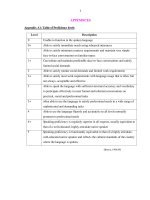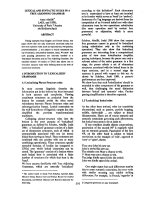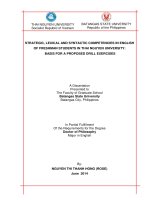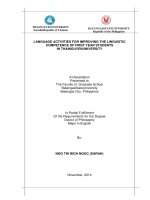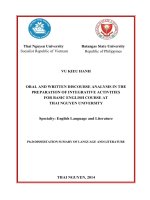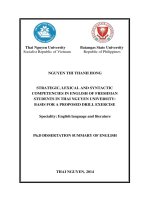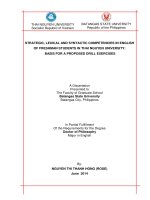strategic, lexical and syntactic competencies in english of freshman students in thai nguyen university bais for a proposed drill exercises (sum)
Bạn đang xem bản rút gọn của tài liệu. Xem và tải ngay bản đầy đủ của tài liệu tại đây (347.85 KB, 26 trang )
Thai Nguyen University Batangas State University
Socialist Republic of Vietnam Republic of Philippines
NGUYEN THI THANH HONG
STRATEGIC, LEXICAL AND SYNTACTIC
COMPETENCIES IN ENGLISH OF FRESHMAN
STUDENTS IN THAI NGUYEN UNIVERSITY:
BASIS FOR A PROPOSED DRILL EXERCISE
Speciality: English language and literature
Ph.D DISSERTATION SUMMARY OF ENGLISH
THAI NGUYEN, 2014
The Dissertation was completed in:
THAI NGUYEN UNIVERSITY
Advisor: Dr. Amada G. Banaag
Reviewer No.1:
Reviewer No.2:
Reviewer No.3:
The Dissertation will be evaluated at the State Council held at:
………………………………………………………………………
At: hour date month year 2014
Dissertation can be found at the libraries:
- National library of Vietnam;
- Learning Resource Center - Thai Nguyen University;
- Library of International Training and Development Center;
- Library of Batangas State University, Philippines.
1
CHAPTER I
THE PROBLEM
1.1. Introduction
English language is considered a significant tool for
communication in the 21
st
century as the world becomes global
business and communication such as news and information, business,
finance, entertainment, maritime and air traffic communication. It is
also the language that plays an important role in government
diplomacy, science, medicine and other profession.
Further, often referred to as the world‟s language, English is
widely spoken. Knowledge also of the English language to enhance
educational attainment through improved communication ability is
also important. It enables people of different countries to converse
and do business with each other. One of the biggest advantages of a
country in a global job market is the proficiency of the skilled
workers in the English language. In the field of education,
proficiency in the English language also improves academic
performance of students.
Proficiency in the English language has been identified as a
requisite in the globalized economy; with countries having a large
number of its population capable of communicating in English being
rewarded with economic advantages. In Asian countries, this trend
has been realized by both governments and individuals and are thus
pushing the wide interest in English language study in the last ten
years. Vietnam is no exemption to this trend considering that it is
one of the non-native speakers of the English language. In the 2011
study of the organization EF Education First Ltd., Vietnam was
2
shown to have an EF English Proficiency Index (EF EPI) of 44.32 or
very low proficiency close to Thailand that is 39.41. This EF EPI is
the first of its kind index comparing the English proficiency of non-
native English speaking countries calculated from 2,368,730 test
takers across 42 countries and two territories, accumulated from 2007
to 2009. In the following year that is in 2012, Vietnam showed and
EF EPI of 52.14 or low proficiency, an improvement from the
previous year in comparison with Thailand which got a value of
44.36 or very low proficiency.
Vietnam issued the Government Decision 1400 in 2008 whose
goal is to renovate thoroughly the tasks of teaching and learning
foreign languages within the national educational system and through
its Ministry of Education and Training (MoET) National Foreign
Language 2020 Project, or Project 2020 which aims to embark on an
ambitious education reforms where all school levels will be required
to have a minimum level of English by 2020. Under this program,
Vietnam does not only want majority of its students to be able to use
a foreign language, especially English, confidently in their study,
daily communication and work by 2020, but demands that its high
school teachers are competent on the second highest skill level (C1),
the elementary school teachers on the fourth highest level (B1) and
middle school educators the third-highest (B2).
According to Dr. Diana l. Dudzik, a senior fellow at an education
ministry project on foreign language improvement, students who
have studied English for seven years beginning in grade six are often
not able to use English beyond simple greetings and questions such
as “hello”, “good-bye” and “what‟s your name?”. This problem is
3
magnified when the students enter the tertiary level, as freshman
students, when they definitely will be handicapped to tackle more
advanced tasks in learning not only in the English language but in
other subjects such as Science and Mathematics where English is the
medium of instruction.
As an applied component of language, communicative
competence is the ability of the speakers to use different functioning
rules of the system. It involves speaker‟s grammatical knowledge of
syntax, morphology and phonology. It also includes the social
knowledge of the speaker in the appropriate use of language.
Knowing English involves speaking, writing, listening and reading.
Producing the language correctly as well as using the language for a
particular purpose is part also of communication in English. When
speakers are able to perform the needed communicative functions,
they achieve communicative competence in the language.
A person‟s knowledge of the language and his ability to use that
language in order to interpret and produce meaningful texts
appropriate to the situation in which they are used manifests that
person‟s language competence. This can be developed through
activities or tasks utilized in real situations or practical applications.
In the case of students, they can develop their language competencies
through meaningful classroom activities and language use in contexts
based on their needs, interests, and experiences. As students are
involved in various aspects of the task itself, not in isolation, it is
necessary to teach, practice and assess the vocabulary, grammatical
structures, text forms, and social conventions important to carry on
this task. Thus, the objective of the Vietnamese L2 learners is to
4
achieve a certain level of communicative competence in the areas of
grammatical, socio linguistic, strategic competence and discourse
competence.
Based on the researcher‟s observation and as an English teacher
teaching the subject for several years, most of the students encounter
difficulties along grammar and vocabulary as well as their inability to
use varied communication strategies. Through this study, student
problems along these areas would be identified and remedied through
drill exercises designed to enhance their strategic, lexical and
syntactic competencies.
1.2. Statement of the Problem
1.2.1. What are the strategic competencies of Freshman students?
1.2.2. What is the level of students‟ lexical competence relative to:
- vocabulary;
- idioms;
- word formation; and
- antonyms/synonyms?
1.2.3. What is the level of students‟ syntactic competence in terms of:
- subject verb agreement
- verb tenses
- direct and indirect speech
- phrases and clause
- pronoun references
1.2.4. Are there significant relationships between each pair of
students‟ lexical and syntactic competence?
1.2.5. Are there significant relationship between lexical and syntactic
competencies?
5
1.2.6. How do teachers assess the students‟ lexical and syntactic
competencies?
1.2.7. What drill exercises may be prepared toward improving the
students‟ communicative competence?
1.3. Scope, Delimitation and Limitation of the Study
This study covered the responses of 382 freshman students
selected randomly from five different universities in Thai Nguyen as
well as the responses of 57 English teachers who have experience in
teaching freshman students. The responses of the students to the
validated lexical and syntactic questionnaire were gathered and
statistically analyzed. The study was conducted in an urbanized
setting covering a period of six months from July to December 2013.
The students and teachers demographic background were not
included in this study nor the identity of the respondents be gathered.
Stratification of the students and teacher respondents were not done
nor their gender was considered. The respondents includes freshman
students who are currently enrolled in an English course in the
University. The teacher respondents also included those who are
currently teaching freshmen English courses. This study covered the
three competencies namely strategic, lexical and syntactic
competencies. It does not include discourse competence.
1.4. Significance of the Study
1.4.1. The Students.
Students will largely benefit from the findings of this work as it
will establish their current level of lexical and syntactic competencies
and thus identify their areas of handicap which will be used as basis
for the design of remedial strategies.
6
1.4.2. Teachers
Through this research, college leaders, teachers of English are
aware of students‟ strategic, lexical and syntactic competencies in
Englishand their responsibilities for designing a suitable curriculumn
as well as learning materials to improve students‟ competencies in
english.
1.4.3. Administrators and Policymakers
The college leaders, college managemers of the universsities
in Thai Nguyen in general and in the foreign languages departments
in particular may refer to the results of dissertation to enhance the
training quality and improving the students‟ competencies in english
to meet the demand of National Foreign Language 2020 Project. This
study is also important to them to institute teaching reforms and
insure the implementation of innovative strategies towards the
improvement of English language teaching
CHAPTER II
REVIEW OF LITERATURE
2.1. Synthesis
The a literatures review of the study provided rich background on
the constructs regarding strategic, lexical and syntactic competencies
of the study.
The concepts of Chomsky, Kroy, O‟Grady, Philips, Fernandez,
Evans and Kac were used in the discussion of the topic competence
in the English language while the ideas of Jaimes, Canale and
Bachman on communicative competence added more information to
the mentioned subject matter. Dornyei et.al, Yule, Stern, Gallagher,
7
Maleki and Richard constructs enrich the explanation of the topic
about strategic competence. Further, Parbakht, Bachman, Canale and
Swain, Brown and Jenkins et.al insights on the importance of
strategic competence in compensating problems in communication
supported the discussion relative to stated concepts. The ideas on
syntactic competence as explained by Brown, Loban, Hunt, Smith,
Chomsky, Burgess, Baker, Miller and Radford contributed very
much in the discussion on the importance of having syntactic
competence in the English language. The elaboration of the concepts
on lexical competence was provided by Laufer, Meara, Doller et al,
Segler et.al, Gass, Richards, Robinson and Alejandro. Further, ideas
along this topic were also provide by Far, Faerch et.al, laufer et al,
Lafford et.al and Marconi. As regard to the discussion on the
concepts regarding drill exercises in language teaching, the constructs
of Rivers, Nelson, Bratt and Bruder, Carroll and Politzer provided
ample background.
For the research studies reviewed, the following find similarities
and differences to the present study: The studies of Abdaqui,
Miyakoshi and Nizonkiza , the studies of Gonzales and Butler
In addition, the studies of Lorimor on conjunctions and
grammatical aspect as well as that of Matsuzaki in verb meanings and
their effects on syntactic behavior find similarity to the present study
as the level of syntactic competence in terms of subject verb
agreement, verb tenses, direct and indirect speech, phrase and clauses
and pronoun references are covered in the present study. Zareva‟s
study on the other hand is also similar to the present study as both
8
studies deals with lexicon but differs on the respondents as well as
the output of the study.
2.2. Theoretical Framework
The study is anchored in Stephen D. Krashen theory of second
language acquisition (SLA), Lyle F. Bachman‟s theory of
communicative competence and Simon Dik‟s functional grammar
2.3. Conceptual Framework
The components of the study were classified as input, process and
output as presented in Figure 1.
INPUT PROCESS OUTPUT
Figure 1: Research Paradigm
Drill exercises to
improve the
student‟s
communicative
competence
Assessment
made through:
Test
Questionnaire
for students
Survey
Questionnaire
For Teachers
A. strategic
competencies of
Freshman student
B. level of students‟
lexical competence
relative to:
vocabulary
idioms
word formation; and
antonyms/ synonyms
C. level of students‟
syntactic competence
in terms of:
subject verb agreement
verb tenses
direct and indirect
speech
phrases and clause
pronoun references
9
CHAPTER III
RESEARCH METHOD AND PROCEDURE
3.1. Research Design
This study made use of descriptive method of research to
determine the strategic, lexical and syntactic competencies in English
of freshman students in Thai Nguyen University. The purpose of
using this method is to acquire accurate, factual, and systematic data
that can provide an actual picture of that data set reviewed.
3.2. Subjects of the Study
The subjects of the study comprised of 382 college students
selected through random sampling out of 8,540 total population and
57 teachers of the five universities in Thai Nguyen City. The students
were enrolled in a freshman English course at the time of sampling or
had taken a freshman English course in the previous semester. The
distribution of the respondents is shown in Table 1.
Table 1: Distribution of the respondents of the study
Name of
University
Population
Number
of Class
Selected number
of student
respondents
Number of
teacher respondents
University of
Education
2,200
36
99
19
University of
Medicine and
Pharmacy
1,140
17
51
7
University of
1,400
23
62
8
10
Sciences
University of
Communication
and Information
Technology
1,300
22
59
15
University of
Agriculture and
Forestry
2,500
41
111
8
TOTAL
8,540
139
382
57
As shown in the table, the distribution of respondents to the five
universities were as follows: for the University of Education which
was composed of 36 classes, it had the total population of 2,200
where 99 students were randomly selected by selecting I student for
every 22 students while in the University of Medicine and Pharmacy,
51 students were chosen out of 1,140 population from 17 classes.
Meanwhile, in the University of Sciences, 62 students were selected
out of 1,400 population from 23 classes, while in the University of
Communication and Information Technology 59 students were taken
as respondents out of 1,300 population from 22 classes. In the
University of Agriculture and Forestry out of 2, 500 population,111
students were selected from 41 classes, a total of 382.
As for the teacher respondents, their total number for the five
universities are 57 distributed as follows: 19 teachers from the
University of Education, seven from the University of Medicine and
Pharmacy, eight from the University of Sciences, 15 from the
University of Information Technology and eight from the University
of Agriculture and Forestry, a total of which is 57.
11
3.3. Data Gathering Instrument
The following were the data gathering instruments used in the
study:
Teacher Made Test. This was used to assess the level of
Freshman students‟ lexical competencies in terms of vocabulary,
idioms, word formation, as well as antonyms and synonyms; and
syntactic competencies which cover subject-verb agreement, verb
tenses, direct and indirect speech, phrases and clauses as well as
pronoun references.
Survey Questionnaire. This was used to elicit data from teachers
handling English subject as to their assessment of the Freshman
students‟ strategic, lexical and syntactic competencies.
For the teacher responses on the frequency of use, the score
ratings were based on a Likert scale where the numerical values were
assigned to corresponding frequencies as follows:
Scale
Range
Verbal Interpretation
5
4.50-5.00
Always (A)
4
3.50-4.49
Often (O)
3
2.50-3.49
Sometimes (S)
2
1.50-2.49
Rarely (R)
1
1.00-1.49
Never (N)
For the teacher responses on the degree of importance, the score
ratings were based on a Likert scale where the numerical values were
assigned to corresponding degree of importance as follows:
12
Scale
Range
Verbal Interpretation
5
4.50-5.00
Very important (VI)
4
3.50-4.49
Moderately important (MI)
3
2.50-3.49
Slightly important (SI)
2
1.50-2.49
Less important (LI)
1
1.00-1.49
Not important (NI)
Data Gathering Procedure
The teacher made test and survey questionnaire were designed
based on the statement of the problem. The former was subjected to a
dry-run to a different set of population not less than 30 individuals
that are not the respondents of the study and the latter by 30 English
teachers to determine the strength and weaknesses of the instruments
and further subjected to validations by expert on the field and panel
members. After the instruments were validated, letters of requests
were written and sent to the administrators of the five universities for
the administration of the questionnaires.
The student respondents of the respective universities were
gathered in their respective assigned room for the testing. The
questionnaires were then administered to the respondents. The
students of the five universities were given 60 minutes to answer the
test. Instructions were also provided to them on how to answer the
test. As soon as the test was over, test questionnaires were retrieved.
As for the teacher respondents, the questionnaires were brought to the
Department of Foreign Languages of each university for the English
teachers to accomplish. Like the test questionnaire, as soon as the
teacher respondents were done with the task, the survey
13
questionnaires were then retrieved. Test and survey questionnaires
were then checked, tallied and analysed.
3.4. Statistical Treatment of Data
The study applied the following statistical treatment:
Cronbach alpha. This was used to measure internal consistency
of the scores of the respondents.
Frequency Count. This was used to determine the number of
responses for each item.
Mean. This was used to determine the average score of the
students in the teacher -made- test
Percentage. This was used to determine the magnitude of the
frequency in relation to the whole responses.
Ranking. This was used to determine the positional importance
of responses.
T- test. This was used to find out the significant mean difference
of the treatment being compared.
CHAPTER IV
PRESENTATION, ANALYSIS AND INTERPRETATION OF DATA
This chapter presents the results of the data gathering process from
the respondents of the study, the data analysis and its interpretation as
follow:
1. Strategic competencies of freshman students
2. Student skills according to the frequency of use asa strategic
competence
3. Degree of importance of strategic competency
14
4. Level of students‟ lexical competence
5. Performance of students on Lexical competence
6. Level of students‟ syntactic competence
7. Performance of students on syntactic competence
8. Relationships between the students‟ lexical and syntactic
competence
9. Students‟ t-test comparison of the mean scores for each lexical
test
10. Students‟ t-test comparison of the mean scores for each syntactic
test
11. Students‟ t-test comparison of the mean scores for lexical vs
syntactic test
12. Teachers‟ assessment of the Students‟ lexical and Syntactic
competencies
13. Students‟ frequency of lexical and syntactic skills
14. Mean scores of lexical and syntactic skill
15. Relationship between on the teachers‟ assessment and the level
of students‟ lexical and syntactic competencies
16. Student‟s t-test comparison of the mean scores for lexical and
syntactic test
17. Drill exercises that can be prepared to improve the students‟
communicative competence.
18. Areas under lexical-syntactic competencies to be used as topics
for the design of drill exercisex and the basis of their choice
15
CHAPTER V
SUMMARY, CONCLUSION AND RECOMMENDATION
5.1. Summary of Findings
This study aimed to assess the strategic, lexical and syntactic
competencies in English of Freshman students in Thai Nguyen
University. This sought answers to the following research questions:
5.1.1. What are the strategic competencies of Freshman students?
5.1.2. What is the level of students‟ lexical competence relative to:
- vocabulary;
- idioms;
- word formation; and
- antonyms/synonyms?
5.1.3. What is the level of students‟ syntactic competence in terms of:
- subject verb agreement
- verb tenses
- direct and indirect speech
- phrases and clause
- pronoun references
5.1.4. Are there significant relationships between the students‟ lexical
and syntactic competence?
5.1.5. How do teachers assess the students‟ lexical and syntactic
competencies?
5.1.6. Are there significant differences between on the teachers‟
assessment and the level of students‟ lexical and syntactic
competencies?
5.1.7. What drill exercises may be prepared toward improving the
students‟ communicative competence?
16
The study made used of descriptive research. The respondents of the
study comprised of 382 freshman students and 57 college teac hers.
The data gathering instruments used were survey questionnaires
for the teacher respondents and the teacher made test for the students
respondents. Statistical tools used were Cronbach alpha, frequency
count, mean, percentage, ranking, and T- test.
5.2. Findings
The following were the findings of the study:
5.2.1. Strategic Competencies of Freshman Students
In the assessment of the strategic competency of freshman
students of Thai Nguyen University, a survey questionnaire was
utilized for the evaluation of the sixty teacher respondents. Results
revealed that majority or 11 out of 14 skills of the students‟ skills are
considered strategic competencies by the teacher respondents and are
thus employed by students to cope and promote their communication
goals. Two skills had the most number of “Agree” response namely:
(12) To remain in the conversation and to gain time to think, the
students use certain conversational formulae or „prefabricated
conversational patterns‟ such as fillers or hesitation devices like : I
see; Well, as a matter of fact; I mean; actually; you know ; and (14)
The student appeals for help to the speaker like “I‟m sorry but I don‟t
think I understood you. . . or I‟m sorry but I couldn‟t follow you.
As regard to the frequency of use of students‟ skills as strategic
competency, results revealed that freshman students in general,
employ strategic competency skills from a relatively wide range of
scores from 2.30 to 3.82 which corresponds to the Likert rating of
“rare” to “often”. The most frequent scoring item is the student skill
(1) During a conversation, the student avoids a topic when he doesn‟t
17
understand. This together with the other higher scoring items such as
items (2) The student abandons the message if he doesn‟t know what
it means, (4) The student use polite words like “Excuse me or Will
you please explain what you mean?” on the message he doesn‟t
understand, (6) The student addresses the speaker with a question
like “What do you call this?” to seek clarification of the message all
belong to reductive strategies. Only items (10) The student uses non-
linguistic means like mime, gesture, or imitation, and, (12) To remain
in the conversation and to gain time to think, the students use certain
conversational formulae or „prefabricated conversational patterns‟
such as fillers or hesitation devices such as I see; Well, as a matter of
fact; I mean; actually; you know are the high scoring items among
the achievement strategies.
This clearly reflects the underdeveloped state of strategic
competencies of this population of students as perceived by the
teacher respondents. This also means that the students favor the use
of reduction strategies as compared to achievement strategies.
Further, in relation to the degree of importance of these skills as
strategic competency , results indicated that majority of the student
skills considered important by the teacher respondents are
achievement strategies which include items (12) To remain in the
conversation and to gain time to think, the students use certain
conversational formulae or „prefabricated conversational patterns‟
such as fillers or hesitation devices like I see; Well, as a matter of
fact; I mean; actually; you know, (9) The student uses
approximation that is using a term which expresses the meaning of
the target lexical item as closely as possible like „ship‟ for „sailing
boat‟, or „fish‟ for „carp‟.
18
5.2.2. Level of students’ lexical competence
To evaluate the level of lexical competence of 389 student
respondents of Thai Nguyen University the instrument used is a
teacher made – Test comprising of 10 items in the areas of
vocabulary, idioms, word formation, antonym and synonym is the
instrument. In the area of vocabulary, the student respondents got
poor performance as indicated by their average score of 48.2 percent
which is below 50 percent with standard deviation of 15.3 percent
which shows students homogeneous performance, while in the use of
idioms, similar to the result of vocabulary, the student respondents
got poor performance as indicated by their average score of 38.4
percent which is even lower than vocabulary score though the score
is below 50 percent with standard deviation of 13.9 percent showing
their homogeneous performance to that of vocabulary scores.
For word formation, student respondents got 45 percent average
of correct score which is below 50 percent equally low to that of
vocabulary scores which shows their poor skill along this area with
standard deviation of 28.4 percent indicating more heterogeneous
student performance in word formation. As regard synonym and
antonym, student respondents got better performance score as shown
in their average score of 67.2 percent which is above 50 percent with
standard deviation of 26.3 percent indicating heterogeneous student
performance.
5.2.3. Level of Students’ Syntactic Competence
The areas evaluated that comprised the teacher- made test used to
evaluate the syntactic competence of the 389 student respondents of
Thai Nguyen University include Subject-Verb Agreement, Verb
19
Tenses, Direct and Indirect Speech, Phrases and Clauses, and
Pronoun References with 10 items each.
In Subject-Verb agreement test, student respondents have better
performance in this area as indicated in their average score of 60.1
percent which is above 50 percent with standard deviation of 14.5
percent which means that their syntactic performance is
homogeneous and that the student respondents develop a certain
degree of competency along this area. As regard to verb tenses, the
student respondents got poor performance as indicated in their
average score of 48.6 percent which is below 50 percent with
standard deviation of 18.5 percent showing moderate heterogeneity
among student respondents‟ scores.
Further, , student respondents got poor performance in the area of
direct and indirect speech as indicated by their average score of 47.9
percent which is below 50 percent with standard deviation of 20.9
percent indicating the most heterogeneous score among the students‟
respondents. For phrases and clauses, students got the highest mean
score of 71.5 percent in the entire test groups which imply their
remarkable proficiency in this area and the effectiveness of teaching
pedagogy of teachers.
For pronoun references on the other hand, student respondents got
an acceptable performance as indicated in their average score of 53.4
percent which is above 50 percent with standard deviation of 18.9
percent showing the moderate heterogeneous scores of student
respondents in compared to other tests.
20
5.2.4. Relationships between the Students’ Lexical and Syntactic
Competence
Vocabulary mean score is significantly different from idioms and
antonyms/synonyms but not significantly different from word
formation. This means that vocabulary scores can be predictive of
word formation scores and vice versa. In addition, the mean score
obtained by idioms indicates no relationship among other areas like
antonym/synonym and thus both are independent.
In addition, the mean scores for Subject-Verb Agreement is
significantly different from all other test groups indicating no
relationship also with the rest of the other test group; for Verb Tenses
is not significantly different from Direct and Indirect Speech but
significantly different from other test groups; while for Phrases and
Clauses as well as Pronoun References, their mean scores are
significantly different indicating no relationship with the other test
groups and are therefore independent.
5.5.5. Teachers Assessment of the Students’ Lexical and Syntactic
Competencies
Teacher respondents assess students‟ lexical and syntactic
competencies. Results of the survey revealed that out of 22 items
eight obtained 50 percent of Agree score which include students
answering the questions pertaining to the applications of antonyms,
correct subject-verb agreement, correct verb tenses, prepositional
phrases. It also includes recognizing the correct subject-verb
agreement in the given sentences; recognizing the correct reported
speech in the sentence.
As regard to constituent items which included recognizing the
meaning of a given word, identifying appropriate idiomatic phrase in
21
a given sentence, recognizing of a root word corresponding to a given
affix, as well as synonym of the word “authentic”, and the antonym
of the word “excessive”, the correct subject-verb agreement in the
sentence, the correct verb tense in a given sentence, recognizing the
correct reported speech and prepositional phrase in the given
sentences, as well as subordinate clause and correct pronoun
reference obtained alpha values below 0.5 which indicate
unacceptability and could be inferred that the teacher respondents did
not grasp the concept of the questionnaire or the teacher respondents
have inadequate competence in teaching Basic English.
As regard to teacher respondents‟ assessment as to frequency of
students in utilizing the skills in answering the lexical and syntactic
questions in class, results indicate that out of eleven items seven have
the mean score of 3.0 which means that the lexical and syntactic
skills are not frequently used or practiced by students. As for the
degree of importance, result indicated that all the mean scores were
4.0 with verbal interpretation of moderately important. Though the
scores appear to be higher than the frequency scores, it means low
considering that respondents are English teachers. It means that
teacher respondents value only lexical and syntactic competence as
moderately important.
5.2.6. Relationship between the Teachers’ Assessment and the
Level of Students’ Lexical and Syntactic Competencies
Comparison of the mean % score of the students‟ lexical and
syntactic performance as well as of the frequency of use of lexical
and syntactic skills as perceived by teacher respondents was
performed using the Student‟s t-test to determine the relationship
between the teacher respondents and the level of student‟s lexical and
22
syntactic performance. Result indicates that a relationship exists
between the items with p values of =0.260828, =0.132316; and
=0.607850. The rest of the mean combinations showed significant
relationship indicating no relationship.
5.2.7. Drill Exercises that can be Prepared to Improve Students’
Communicative Competence
The drill exercises prepared were based on the items involving
students‟ skills that have significant relationship to the lexical and
syntactic competence test scores since it is the inherent objective of
the study to improve the communicative skills of the students. In
addition, the drill exercises include three areas in lexical competency
such as idioms, word formation, and vocabulary; as well as another
three areas for syntactic competency which covers pronoun
references, verb tenses, direct and indirect speech, where the
students showed poor performance. In addition, the drill exercises are
also based on the significant relationship that exists between the
mean scores in T-test comparison of lexical versus syntactic
competencies.
5.3. Conclusions
Based from the findings of the study, the following conclusions were
drawn:
5.3.1. Majority of the freshman students of Thai Nguyen University
employed strategic competencies to cope and promote their
communication skills.
5.3.2. In terms of lexical competencies, freshman students have
poor performance in the areas of vocabulary, idioms and
word formation but have better performance in synonyms
and antonyms.
23
5.3.3. As regard to syntactic competencies, freshman students
demonstrate poor performance in the areas of verb tenses,
direct and indirect speech, but have better or remarkable
performance in the areas of subject verb agreement, pronoun
references and phrases and clauses.
5.3.4. There is no significant relationship exists between students‟
lexical and syntactic competencies.
5.3.5. Teachers‟ assessed that freshman students did not frequently
used or practice their lexical and syntactic skills as indicated
by their mean score of 3.0.
5.3.6. There exists a relationship between teachers‟ assessment and
the level of students‟ lexical and syntactic competencies.
5.3.7. The drill exercises formulated contains activities geared
towards improving freshman students‟ lexical and syntactic
competencies.
5.4. Recommendations
From the findings and conclusions of the study, the following
recommendations are offered:
5.4.1. English Teachers handling the subjects maybe given more
trainings and workshops in teaching content areas of the
course.
5.4.2. The proposed drill exercises maybe presented to school
administrators for review, suggestions and evaluation.
5.4.3. Follow up studies maybe conducted on aspects related to the
variables of the study.
5.4.4. The research did not assess all elements of students‟ lexical
and syntactic competence, such as phrasal verbs,
collocations, gerund and infinitive, comparisons,
